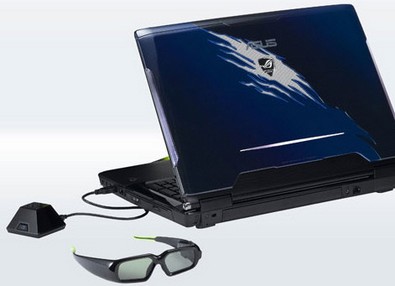Popped along to an Nvidia roadshow a few days back to hear about how the company’s 3D plans were progressing. The Nvidia 3D Vision tech was first announced a couple of years ago, and it’s taken this long for the momentum to build to a point where we’re seeing a reasonable number of manufacturer’s jump on the bandwagon to deliver 3D movies and gaming on name brand hardware.
On view at the roadshow were the new Asus G51JX 3D laptops, the first in the world with 3D functionality built in, and various monitors and supporting technologies for the whole 3D experience. The idea is you buy a 3D glasses kit (with a desktop PC video card), or use a 3D capable peripheral (like a monitor, laptop or projector)and attach an emitter (the thing that synchs your glasses) to a monitor which can cope (i.e. runs at 120 Hz to cope with decent frame rates for each eye at 60 Hz.)
So what impressions did I come away with from the session?
- It can be very impressive. The 3D is really multi-dimensional, and the image can literally spring out at you through the active shutter glasses (they turn black every other frame to deliver the 3D effect) and deliver an amazing depth of field.
- The technology is still clearly *very* new. This is not something you’re going to give your Gran for Christmas, unless you want to spend a fair amount of tech support time over at her house. There are synch settings to set, and if you get it wrong, you have to track down the problem in different areas (e.g. is the resolution set, the eye synch the right way round etc).
- You lose a lot of clarity, and most importantly brilliance in the image. This has the effect of making the experience quite muddy. This is a feature of 3D in general, even Avatar had patches where the 3D image was sub-optimal in this regard. Gamers expecting to play moody titles with lots of atmospheric indoor sections may have difficulty seeing properly, even with the brilliance and gamma turned fully up.
- Headaches. This tech definitely does not do away with the potential to deliver headaches. I felt a twinge after a few minutes, and I never get headaches. I heard other people in the room mention it too. It was nothing more than a twinge of nausea/unsettled stomach, but it was definitely there. So if you’re susceptible, be aware of the fact. Interestingly enough, I felt nothing at all after watching Avatar for near on 3 hours with those passive polarized glasses.
- Watching the pre-release beta of Mafia 2 being demoed was super impressive. The 3D was gorgeous, the gameplay fitted in perfectly and the lower light levels didn’t matter (it was an outside scene anyway).
- The emitters are very sensitive to interruption which in turn flickers the glasses, which in turn could be responsible for eyestrain et al.
- By the time I left the 3D Vision Surround demo (i.e. with 3D on three monitors – cool eh?) was still not working, another indication that this is early tech.
I came away very impressed with the potential for the technology, the idea of delivering 3D to older non-3D games is amazing (they do it with some astonishing code which literally picks apart game footage frame by frame before re-assembling it in a faux stereoscopic format).
The results are also amazing, strong and gasp-worthy with the right footage. Oh and I forgot to mention that the technology is designed to also deliver 3D for streaming material, consider one day that YouTube content could all be 3D. Already there is 3D material up on the site for demo purposes (do a search).
But personally, I won’t be forming a queue any time soon, for the same reason that I’ll probably not bother too much with 3D movies for the mostpart. The technology is too young, the eyestrain and headache issue too real for me to put up with the marginal benefit in the same way I’m not too bothered with subscribing to HD content. The story in a few years may be different at which point I’ll take another look. Another take on the subject.






Nigel shutter glasses technology is not new it's been around for quite sometime and Nvidia purchased the technology from ELSA who made 3D glasses in the early 00's. The losing sync issue has always been around they never seem to be able to fix it and the reason "old games" can have 3D added to them (which is not "faux 3D") is because they use DirectX, which is a 3D API so although the monitor traditionally deals with 2D all the 3D info is behind the scenes for lighting, textures, map depth etc. This has always been there its just the end user doesn't consider or see it in 3D.
Oh excellent, thanks Ben for the expert info. I was going on the rough info I was told, so apologies if it was a bit fast and loose. Has the technology been waiting for the arrival of 120 Hertz monitors and equivalent then?